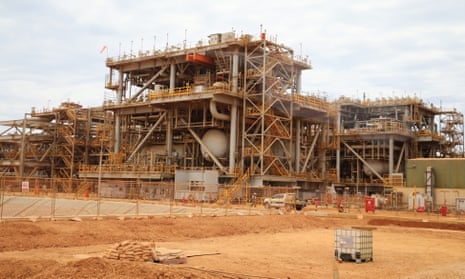Half of the increase in Australia’s annual carbon dioxide emissions can be linked to a single issue: the failure to bury greenhouse gases underground at the country’s largest liquefied natural gas development.
Chevron’s Gorgon LNG development in the Pilbara is considered a landmark development in carbon capture and storage, a long-promised technology to limit emissions from fossil fuels.
Under its agreement with the Western Australian government, the energy giant is required to capture 80% of emissions from an underwater gas field over a five-year period and inject them into a reservoir 2km under Barrow Island. The Minerals Council of Australia chief executive, Tania Constable, last month told ABC the project demonstrated that carbon capture and storage was “coming through very strongly”.
But nearly two years after the start of LNG production from the Gorgon gas field, emissions storage is yet to begin.
A Chevron spokeswoman said technical issues were identified in the commissioning of the storage project and modifications were under way. She said it was expected underground injection would begin by March.
The company said between 3.4m and 4m tonnes of carbon dioxide would be buried each year. It was estimated it would cut Gorgon’s total emissions – counting both fugitive emissions from gas wells and those released during production, when the gas is compressed into liquid form for export – by about 40%. The $2.5bn project is backed by $60m in federal government funding.
A new report has questioned whether the company expects the project to work. The analysis by research group the Australia Institute said Chevron has also applied – and been granted approval – to emit an average of 8.7m tonnes a year to 2020 under the government’s “safeguard mechanism”, part of the Tony Abbott-era Direct Action climate policy.
It said if the injection project does work Gorgon’s emissions would fall from between 8.5m and 10m tonnes to between 5.1m and 6m tonnes a year. The institute’s climate and energy program director, Richie Merzian, said by granting it a higher emissions limit the government was allowing Chevron to plan for the carbon storage project to fail.
Federal government data shows increased LNG production was the main reason national emissions rose by 6.8m tonnes in the year to March. The Australia Institute report suggests the delay at Gorgon’s carbon injection project played a central role, causing emissions equal to half that increase.
“Rather than holding Chevron to account, the Morrison government is giving it as much leniency as it possibly can,” Merzian said.
“It’s another example of the government’s inaction on climate change. If the government isn’t going to address LNG emissions, which is one of Australia’s fastest-growing sectors, then Australia has no hope of meeting its Paris target.”
LNG production in Australia has tripled since 2012, doubled in the two years to 2017 and is expected to grow another 18% this year. The related growth in emissions is projected to effectively wipe out carbon pollution avoided through the 23% renewable energy target.
The LNG industry is covered by the safeguard mechanism, which grants big industrial sites generous pollution limits, known as baselines. The baseline at Gorgon is drawn from Chevron’s projections of how much will be emitted in its biggest production year in the first five years of operation. The company can emit up to that baseline for free, but will have to buy carbon credits to offset any emissions above it. The baseline is expressed as 25m tonnes over the three years to June 2020.
Merzian said the mechanism was next to useless while companies could nominate their own baseline. “It’s like allowing a taxpayer to nominate how much tax they want to pay,” he said.
Based on the cost of carbon credits under the government’s emissions reduction fund, Merzian estimates it would cost Chevron up to $52m a year if it was required to offset the pollution it had agreed to sequester but that is currently being released into the atmosphere.
Neither Chevron nor the federal environment minister, Melissa Price, answered directly when asked if Gorgon’s baseline implied the carbon storage project would not work.
A Chevron spokeswoman said the company had applied for a baseline in accordance with strict regulations overseen by the Clean Energy Regulator, a government agency.
A spokesman for Price said the baseline was calculated based on an audited forecast of emissions intensity and production at full capacity. “Businesses must manage their emissions and keep to [their] limit,” he said.
Price’s spokesman said LNG exports played a role in international emissions reduction efforts by providing a relatively low-emitting fuel source for electricity.
In WA, the Environment Protection Authority is investigating the agreement between the state and the company in light of the delay, including when the five-year period in which it has to bury 80% of fugitive emissions officially started.
After a tour of the Gorgon site in October, state environment minister, Stephen Dawson, was quoted in the West Australian saying he would give the company the “benefit of the doubt” that it would overcome the technical issues the storage project was facing.
The EPA is expected to report back by April. Dawson said it should be clear by then if the carbon injection project would work and whether Chevron could meet the target.
“Discussions will then need to commence on how Chevron can offset the portion not able to be sequestered,” he said.

Comments (…)
Sign in or create your Guardian account to join the discussion